Solar PV Panels For Factory and Warehouse Roofs
Solar photovoltaic (PV) panels for factory and warehouse rooftops are gaining popularity as industries in the UK seek sustainable and renewable energy solutions. This clean energy source helps reduce carbon footprints and supports environmental progress. Whatever you produce, you can lower costs with industrial solar panels and sustainable industrial technology.
By capturing solar power, factories and warehouse businesses with extensive roof spaces can meet their energy needs in an environmentally responsible manner. Excel Energy’s turnkey solar power system installations offer significant economic benefits, substantially lowering energy costs. Here, we explore the features, benefits, and positive environmental impact of installing solar panels on factory and warehouse roofs.
Features of Solar Panels for Factory and Warehouse Roofs
Advanced Photovoltaic Technology
Modern solar panels for factories and warehouses use state-of-the-art photovoltaic (PV) technology to convert sunlight directly into electricity. This process involves several essential steps to ensure efficient energy production:
1. Sunlight Absorption: The panels are composed of photovoltaic cells made from semiconductor materials, typically silicon. When sunlight hits these cells, it excites the electrons, creating an electric field.
2. Electricity Generation: The excited electrons move, generating an electrical direct current (DC). This flow of electricity is captured and channelled through the cells.
3. Conversion to Usable Power: While the initial electricity generated is in DC form, it must be converted to alternating current (AC) used by most industrial equipment and integrated into the power grid. This conversion is carried out by an inverter, an essential component of the solar power system.
These solar PV panels are designed to be highly efficient and durable, ensuring a long-term energy solution for factories and warehouse facilities. They are designed and built to endure tough environmental conditions, such as heavy rain, snow, high winds, and extreme temperatures.
This robustness ensures that the panels maintain their performance and efficiency over many years, with minimal maintenance required.
The latest advancements in PV technology allow the panels to generate more power even in low-light conditions, such as cloudy days or during early morning and late afternoon hours. This improvement is achieved through innovations like bifacial panels, which capture sunlight on both sides and advanced coatings that reduce energy losses.
Furthermore, modern solar panels are frequently equipped with advanced technologies that enhance their efficiency and user-friendliness. Inverter cutting-edge monitoring systems enable real-time tracking of energy production and usage, assisting facilities in optimising their energy management.
These sophisticated solar power inverter monitoring systems offer detailed insights into energy generation and consumption, allowing facility managers to make well-informed decisions about their energy use.
Intelligent monitoring systems provide real-time data that can quickly identify and address any issues with the system, ensuring the solar power system operates at peak efficiency.
These include:
Maximum Power Point Tracking (MPPT): This technology manages the connection between the solar array (PV panels) and the inverter system, ensuring that the greatest possible power is extracted from the PV module cells.
Integrated Smart Metering Systems: These systems allow for real-time solar energy production and consumption tracking, providing valuable data for managing energy use.
Overall, these developments make solar panels a reliable energy source throughout the year, providing consistent and renewable energy that supports the operational needs of factories and warehouse facilities.
By investing in modern PV technology, businesses can achieve energy independence, reduce operational costs, and contribute to a sustainable future.
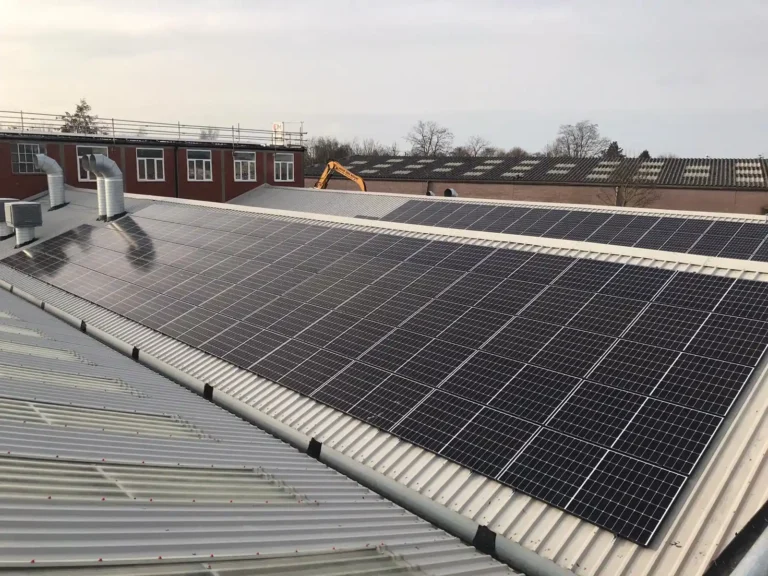
Customisable Solar Panels Installation for Commercial Buildings
Commercial Solar power systems can be customised to fit factory and warehouse roofs with specific designs, sizes, and energy consumption profiles to bolster energy capture and efficiency.
Customisable installation options allow facilities to adjust the placement and angle of panels to achieve the highest possible energy output, providing a solution that aligns with their unique operational requirements and physical infrastructure.
Customisation for Different Roof Types
Flat Roofs: Flat roofs are standard in industrial settings and offer a versatile space for solar panel installations. Mounting systems can be adjusted to tilt the panels at the most favourable angle to capture sunlight throughout the day. The tilt can be adjusted seasonally if needed to maximise year-round efficiency.
Sloped Roofs: Solar panels can be installed using the appropriate mounting system that matches the roof’s pitch for sloped factory or warehouse roofs. This ensures the PV panels are securely mounted and positioned to capture the most sunlight possible. The angle of the slope often aligns with optimal solar angles, simplifying the installation process.
Advanced Solar Mounting Solutions
Ballasted Mounts: These ideal for flat roofs where penetrating the roof membrane is undesirable. Ballasted mounts use weight to hold the panels in place, avoiding damage to the roof structure.
Penetrating Roof Mounts: These are used when a more permanent and secure installation is required, especially on sloped roofs. These mounts are attached directly to the roof structure, providing stability even in high wind conditions.
Adjustable Mounts: These solar tracking mounting systems can be adjusted to change the angle of the panels, which is particularly useful for optimising energy capture in varying seasonal sunlight conditions.
Space Utilisation
Solar array systems can be designed to fit around existing roof structures, such as HVAC systems, skylights, and vents. Advanced design software allows installers to create a layout that allows for the greatest number of panels installed while ensuring that maintenance access to other roof equipment is not hindered.
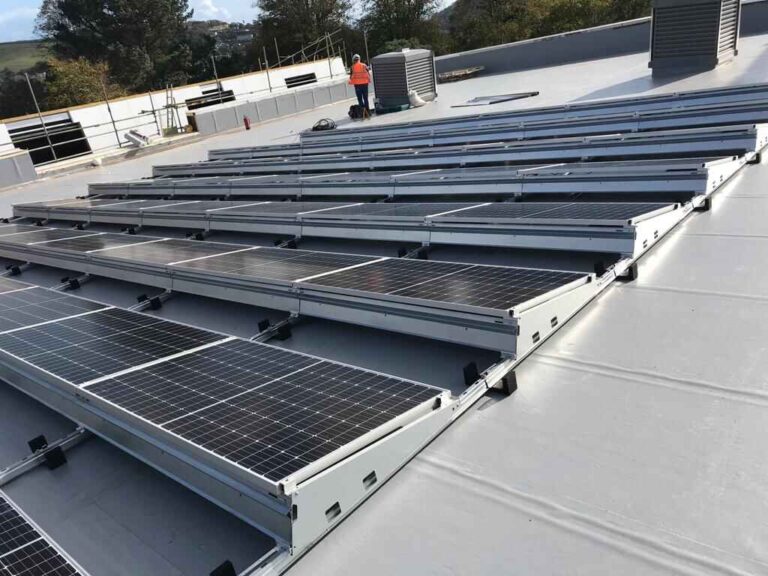
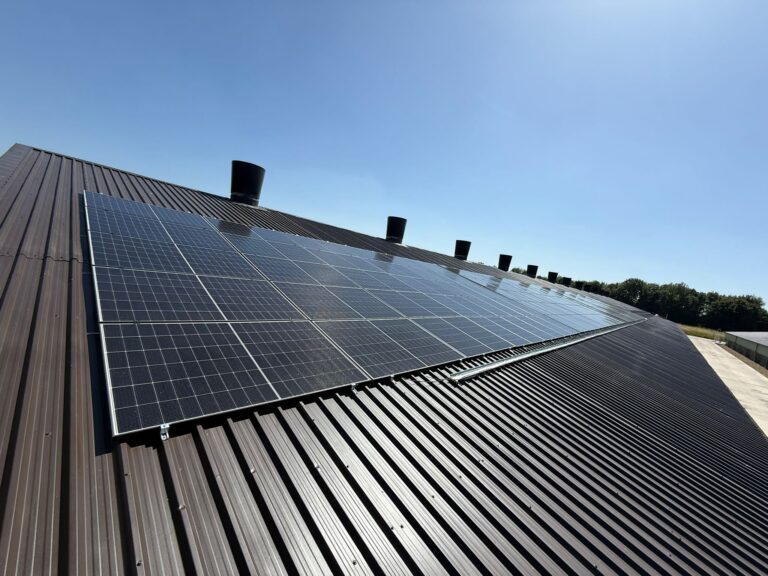
Integration with Building Design
Aesthetic Integration: Solar panels can be integrated for facilities concerned with the visual impact to complement the building’s design. Frameless panels, all-black panels, or even building-integrated photovoltaics (BIPV) that replace traditional building materials with solar panels can be used to maintain an aesthetically pleasing appearance.
Structural Considerations: Engineering assessments ensure that the roof structure can support the additional load of the solar panels. In some cases, roof reinforcements might be necessary to accommodate the system safely.
Optimal Energy Output
Customising the installation to match the specific energy consumption profile of the facility ensures that the solar power system meets the energy demands effectively.
This involves:
Load Analysis: Understanding the energy consumption patterns of the facility to size the solar power system appropriately. This ensures the system can handle peak loads and provides sufficient power throughout the day.
Energy Storage Solutions: Incorporating battery banks to store excess energy generated during the day for use during peak demand times or at night. This approach can further increase energy efficiency and provide greater independence from the grid.
Site-Specific Solutions
Shading Analysis: Tools like solar pathfinders or software simulations like PVsol, PVcase and SolarEdge are used to analyse shading patterns on the roof and place the panels in locations with minor shading, ensuring maximum exposure to sunlight.
Orientation Optimisation: Panels can be oriented in different directions (south, east, west) to capture sunlight at different times of the day, depending on the facility’s energy use patterns.
Benefits of Customisation
By tailoring the solar power system to the specific needs of a facility, businesses can:
Get the Utmost Energy Production: Ensure the system generates the most possible electricity.
Reduce Energy Costs: Optimise energy savings by producing more of their electricity needs on-site.
Augment System Longevity: Customised solutions consider unique environmental and structural conditions, ensuring the system is durable and efficient over its lifespan.
A significant benefit is the ability to tailor solar power systems to factory and warehouse roof’s specific design, size, and energy consumption profiles. This customisation enables businesses to maximise energy capture and efficiency, ensuring they get the most out of their investment in renewable energy.
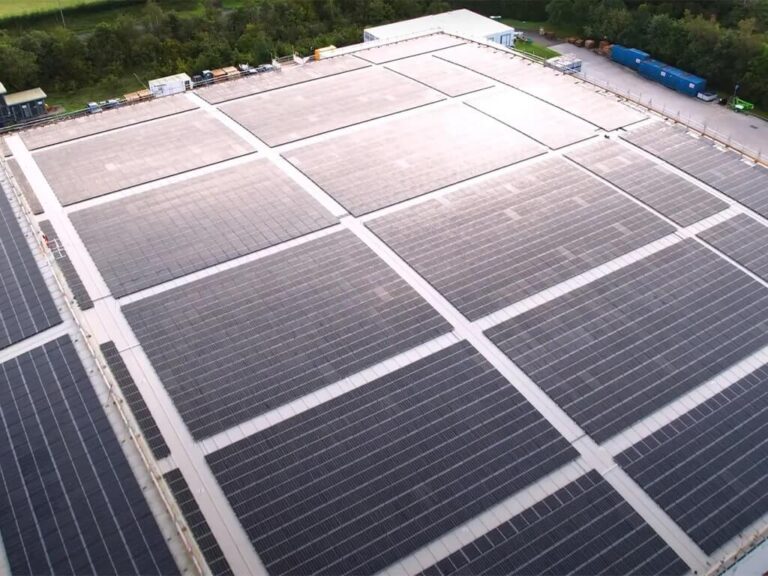
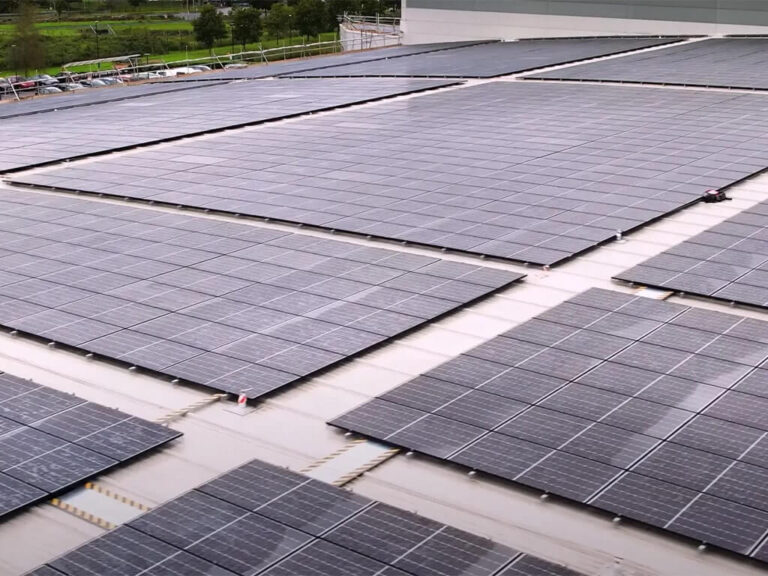
Benefits of Commercial Solar Panels for Factory and Warehouse Facilities
Cost Savings
By harnessing solar energy, factories and warehouse facilities can greatly reduce their dependence on conventional energy sources, resulting in significant savings on electricity bills. The initial investment in solar PV panels is often offset by the long-term reduction in energy costs, making it a financially prudent decision.
Additionally, as energy prices continue to rise, having a solar power system can provide long-term economic stability, giving facility owners a sense of financial security.
Furthermore, the financial benefits extend beyond just electricity cost savings. Factories and warehouse owners can take advantage of various government incentives, tax credits, and rebates designed to promote the adoption of renewable energy. These incentives can significantly lower the initial set-up costs, making the switch to solar power even more attractive. Even opting for a pay over time solution, such as those offered by SmartEase, can still result in monthly savings.
Over time, the savings from decreased energy bills can result in a substantial return on investment, often covering the initial expenditure within just 5 years.
Smart Export Guarantee (SEG) Scheme Benefits
Solar PV technology, one of the five eligible low-carbon technologies under the SEG (Smart Export Guarantee), allows facility owners to earn payments from electricity suppliers for surplus low-carbon electricity exported to the National Grid, provided they meet specific criteria.
To participate, factory and warehouse property owners must apply to a SEG licensee as an electricity supplier offering SEG tariffs to all eligible generators. This initiative is particularly advantageous for facilities with ample roof space, as it contributes to environmental sustainability and helps stabilise their financial viability.
Moreover, solar energy systems require nominal regular maintenance and boast long lifespans, typically ranging from 25 to 30 years. This durability ensures cost benefits extend for decades, providing a stable and predictable energy expense. Unlike typical energy sources, which are subject to market volatility and price increases, solar energy offers a consistent and often lower cost for electricity generation.
In addition, energy independence is a critical factor. By generating electricity, factory and warehouse businesses are less susceptible to energy supply disruptions and can maintain operations even during grid outages. This reliability is crucial for factory and warehouse processes that require a continuous power supply and can prevent costly downtime.
Overall, solar energy offers multifaceted economic benefits for factories and warehouses. These include direct savings on energy costs, long-term financial stability, government incentives, increased facility value, and enhanced reputation. By switching to solar power, facilities can secure a more sustainable and economically viable future.
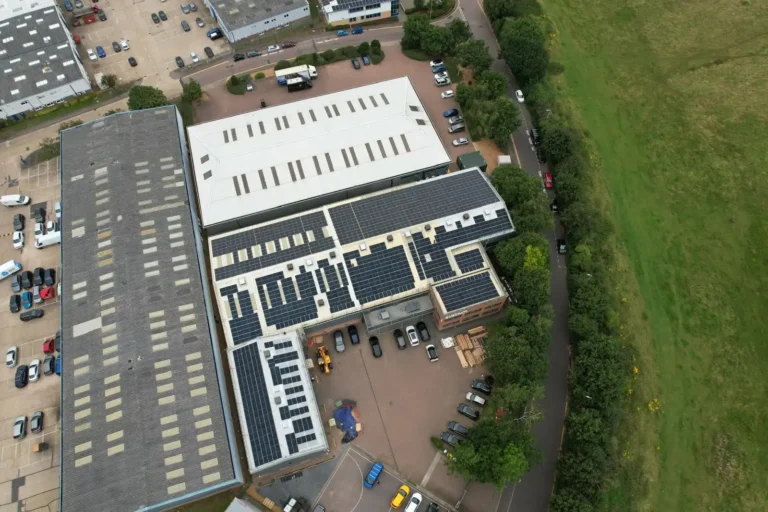
Positive Environmental Impact of solar panels for factories and warehouses
Reduction in CO2 Emissions
Carbon Offsetting
By embracing carbon offsetting through commercial solar PV systems, businesses demonstrate environmental stewardship and pave the way for their industry peers to adopt sustainable practices. This proactive approach helps reduce the carbon footprint and aligns with global efforts towards a more sustainable future.
Investing in solar energy for commercial buildings also adds to the facility’s value and can be a strategic asset. Companies with solar PV installations are often seen as leaders in sustainability and environmental responsibility, which can strengthen their reputation and appeal to eco-conscious customers and partners. This positive perception can increase business opportunities and partnerships, further increasing economic advantages.
Transitional Help Government Incentives
Almost £5 billion of funding is available to support UK businesses to become more environmentally friendly as part of the government’s commitment to reaching net zero emissions by 2050. These incentives can significantly lower the initial costs of installing solar panels, making the switch to solar energy even more attractive for facilities. Grants, tax credits, and other financial support measures are intended to champion the widespread adoption of renewable energy technologies.
Conservation of Natural Resources
By relying on solar energy, factories and warehouse facilities help conserve finite natural resources, promoting a more sustainable future. Solar power does not deplete resources like coal, oil, or natural gas, which are limited and environmentally damaging. This conservation effort is crucial for maintaining the earth’s ecological balance and ensuring resources are available for future generations.
Decreased Air and Water Pollution
Contribution to Energy Transition
Factories and warehouse facilities that adopt solar energy play a crucial role in the UK’s transition to renewable energy sources. They set an example for other industries by leading the way in renewable energy adoption. By demonstrating that sustainable practices are possible and beneficial, these facilities inspire other businesses to pursue similar initiatives, accelerating the shift towards a more sustainable energy future.
This can make facility decision-makers feel influential and forward-thinking. Not only are these facilities possible and beneficial, but they are also cost-effective. They inspire other businesses to pursue similar initiatives, escalating the shift towards a more sustainable energy future. This can make facility decision-makers feel prudent and wise in their financial decisions.
Increase your Sustainability Credentials
REGO – Renewable Energy Guarantees of Origin
To further develop sustainability credentials, the REGO scheme, overseen by Ofgem in the UK on behalf of the Department for Business Energy and Industrial Strategy (BEIS), certifies energy suppliers based on their renewable energy generation. Each supplier receives one REGO certificate for every 1,000,000 units (or 1 megawatt hour) of renewable energy produced, confirming the inclusion of renewables in their energy mix. As businesses prioritise sustainability, switching to a green energy tariff with suppliers holding REGO certificates allows them to showcase their commitment to renewable energy. This choice supports corporate social responsibility goals and enhances their brand reputation in an increasingly eco-conscious market.
Upgraded Corporate Image
Utilising solar energy shows a dedication to sustainability, raises the corporate image, and appeals to environmentally conscious consumers and partners. Companies that invest in green technologies often enjoy a better reputation and increased loyalty from stakeholders who prioritise environmental responsibility. This positive image can also attract new business opportunities and partnerships, making facility managers feel proud and responsible for their company’s image.
Success Stories
Embracing solar PV panels for factory and warehouse roofs allows industries to achieve significant cost savings, strengthen their corporate image, and make a meaningful contribution to environmental preservation.
For instance, QuidelOrtho in Pencoed has reduced its energy costs by 35% and improved its sustainability profile by installing solar panels on its roof. Similarly, Qualiturn Products Ltd in Hertford has seen a 42% reduction in energy costs and 25.18 tonnes of CO2 Emissions saved annually, improving its sustainability profile after adopting solar energy.
These success stories demonstrate that the transition to solar energy is a win-win situation. It offers economic and ecological benefits that sustain industrial progress and inspire others to follow suit.
Call 020 3834 9440 or request a free, no-obligation quote with one of our energy experts online to see how much you can save today.
